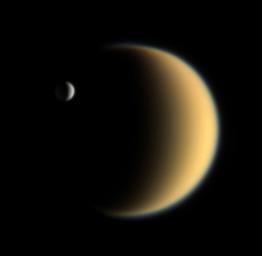Many denizens of the Saturn system wear a uniformly gray mantle of darkened ice, but not these two moons. The brightest body in the solar system, Enceladus, is contrasted here against Titan's smoggy, golden murk.
Ironically, what these two moons hold in common gives rise to their stark contrasting colors. Both bodies are, to varying degrees, geologically active. For Enceladus, its southern polar vents emit a spray of icy particles that coats the small moon, giving it a clean, white veneer. On Titan, yet undefined processes are supplying the atmosphere with methane and other chemicals that are broken down by sunlight. These chemicals are creating the thick yellow-orange haze that is spread through the atmosphere and, over geologic time, falls and coats the surface.
The thin, bluish haze along Titan's limb is caused when sunlight is scattered by haze particles roughly the same size as the wavelength of blue light, or around 400 nanometers.
Images taken using red, green and blue spectral filters were combined to create this natural color view. The images were obtained on Feb. 5, 2006, using the Cassini spacecraft narrow-angle camera at a distance of 4.1 million kilometers (2.5 million miles) from Enceladus and 5.3 million kilometers (3.3 miles) from Titan. Resolution in the original images was 25 kilometers (16 miles) per pixel on Enceladus and 32 kilometers (20 miles) per pixel on Titan. The view has been magnified by a factor of two.
The Cassini-Huygens mission is a cooperative project of NASA, the European Space Agency and the Italian Space Agency. The Jet Propulsion Laboratory, a division of the California Institute of Technology in Pasadena, manages the mission for NASA's Science Mission Directorate, Washington, D.C. The Cassini orbiter and its two onboard cameras were designed, developed and assembled at JPL. The imaging operations center is based at the Space Science Institute in Boulder, Colo.
For more information about the Cassini-Huygens mission visit http://saturn.jpl.nasa.gov/home/index.cfm. The Cassini imaging team homepage is at http://ciclops.org.

 Planetary Data System
Planetary Data System












